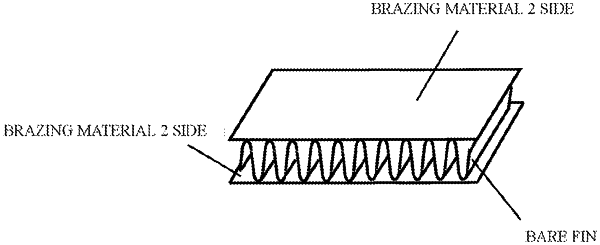| CPC B23K 35/286 (2013.01) [B23K 35/0238 (2013.01); B32B 15/016 (2013.01); C22C 21/02 (2013.01); C22C 21/08 (2013.01); C22F 1/043 (2013.01); C22F 1/047 (2013.01)] | 10 Claims |

|
1. An aluminum alloy brazing sheet used for brazing of an aluminum material in an inert gas atmosphere or in vacuum and
formed of a four-layer material in which a brazing material, an intermediate material, a core material, and a brazing material are stacked in this order,
the intermediate material being formed of an aluminum alloy and having a grain size of 20 to 300 μm, the aluminum alloy comprising Mg of 0.40 to 6.00 mass %, and optionally one or two or more of Zn of 8.00 mass % or less, Si of 13.00 mass % or less, Bi of 1.00 mass % or less, In of 0.100 mass % or less, Sn of 0.100 mass % or less, and Fe of 1.00 mass % or less, with the balance being aluminum and inevitable impurities,
the core material being formed of an aluminum alloy and having a grain size of 20 to 300 μm, the aluminum alloy comprising Mg of 0.20 to 2.00 mass % and further comprising one or two or more of Mn of 1.80 mass % or less, Si of 1.50 mass % or less, Fe of 1.00 mass % or less, Cu of 1.20 mass % or less, Ti of 0.30 mass % or less, Zr of 0.30 mass % or less, and Cr of 0.30 mass % or less, with the balance being aluminum and inevitable impurities,
each of the brazing materials being formed of an aluminum alloy comprising Si of 4.00 to 13.00 mass % and further comprising one or two or more of Mn of 2.00 mass % or less, Ti of 0.30 mass % or less, Zr of 0.30 mass % or less, and Cr of 0.30 mass % or less, and optionally one or two or more of Bi of 1.00 mass % or less, Na of 0.050 mass % or less, Sr of 0.050 mass % or less, Sb of 0.050 mass % or less, Mg of 2.00 mass % or less, Zn of 8.00 mass % or less, In of 0.100 mass % or less, Sn of 0.100 mass % or less, Cu of 4.00 mass % or less, and Fe of 1.00 mass % or less, with the balance being aluminum and inevitable impurities, and
in a drop-type fluidity test, a ratio α (α=Ka/Kb) of a fluid coefficient Ka after a 5% strain is applied to a fluid coefficient Kb before the strain is applied being 0.55 or more.
|